The Ledger
Curated content foranalytical business leaders
Tag Archives: ImpactECS
ImpactECS In-Depth: Item Type Actions
Did you know that ImpactECS models can support user-defined context menu options? The Item Type Actions feature uses custom Script Modules to generate context menus designed to simplify the way users interact with ImpactECS. Not to be confused with cell actions, this article covers the basics of Item Type Actions and highlights a few ways the feature is implemented in real life.
Item Type Action Basics
Setting up Item Type Actions requires model builders perform two steps – displaying the action in the context menu and writing the Script Module to perform the action.
Step 1: Display the Action in the Context Menu
Since this function is powered by scripts, the first step is creating a folder “Actions” in the Script Module folder to help ImpactECS locate the available actions. Once created, add sub-folders for each Item Type that will benefit from context menu functionality (i.e. Calculations, Cost Objects, Forms, …).
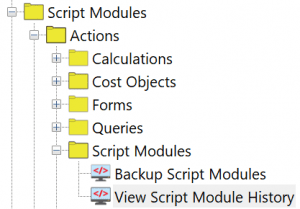
In the example above, notice there is a Script Modules folder inside Script Modules/Actions that has two scripts to generate context menus – Backup Script Modules and View Script Module History. Now when a user right-clicks any script in ImpactECS, those two action functions are available on the context menu as shown below.
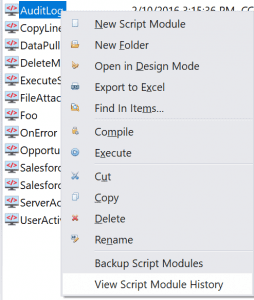
Step 2: Write the Item Type Action Script
ImpactECS offers two arrays programmers can use to script Item Type Actions. SelectedItemNames provides a list of the items the user has selected, while SelectedFolderIDs provides a list of the folders the user has selected. The script below supports the action “Backup Script Modules”.

Ways to use Item Type Actions
The sky is the limit when it comes to Item Type actions, and model builders should consider the best use of these actions to improve model usability and acceptance. Here are a few popular ways ImpactECS models use Item Type Actions:
- Backups: Quickly save items to flat files
- View History: See the modification history of the selected item
- Export and Import Items: Move data between ImpactECS and external systems
- Code Management: Link with external source code management tools
- Modify Items: Make updates and change properties of selected items
Effective use of Item Action Types can significantly improve the user experience of ImpactECS models. Poll your users and identify a few winning ways your can make model users happy with convenient and relevant context menus. Have questions? Check with our team at support@3csoftware.com for more info or to get help implementing this feature.
ImpactECS In-Depth: File Attachments and Images
This article describes incorporating file attachments and images into ImpactECS models. This functionality lends itself to a variety of use cases to expand the information captured in ImpactECS. For example, 3C Software uses file attachments to upload images of receipts into the internal time and expenses model. Another interesting way this feature is used is to upload and attach unique CAD documents or product images to product specific cost objects. It is also another option to integrate custom help documents or view archived reports.
Implementing File Attachments in a Model
When working with external files, model builders have a few different options regarding how to store this information. The initial choice to consider is to simply store the files in a shared directory on the ImpactECS server’s file system. This design, however, has several distinct disadvantages. First, when file attachments are critical, backups are necessary. When stored in this manner, model builders will need to create and manage a distinct backup procedure leading to additional maintenance and complexity. The second (and recommended) file storage option – saving the files in your model’s underlying database and leveraging the backup process already in place for the model. Here’s a sample query to create a database table for storing file attachments:
CREATE TABLE [Files](
[FileID] [int] IDENTITY(1,1) NOT NULL,
[FileName] [nvarchar](255) NULL,
[FileType] [nvarchar](255) NULL,
[FileData] [image] NULL,
[DateUploaded] [date] NULL DEFAULT GETDATE(),
[UploadedBy] [nvarchar](255) NULL,
CONSTRAINT [pk_Files] PRIMARY KEY CLUSTERED ([FileID]))
GOThis query creates a table named “Files” with two fields that are auto-populated when new files are added (or row are inserted): FileID and DateUploaded. The FileID field provides a unique identifier for each file (independent of the file name), while the DateUploaded field indicates when the file was added. The FileData field contains the actual binary (or image) data of the file itself. Here’s a quick screen shot of what this table looks like once files are added:

Once the table is created, a simple script module can attach, view and remove files from the model. Without getting too deep in the technical details, the file attachment functionality is supported by ImpactECS’s “System.GetFileFromClient” method and the file viewing functionality is supported by the “System.OpenTempServerFile” method. More information on both methods can be found in Impact’s online help. But the GetFileFromClient method allows users to browse for a file on their local machine and upload it to the ImpactECS server. While the OpenTempServerFile method transfers a file from the ImpactECS server to the user’s machine and automatically opens it using their default application. Here are a couple of screenshots that demonstrate how this functionality is called using cell actions.

Attaching a file.
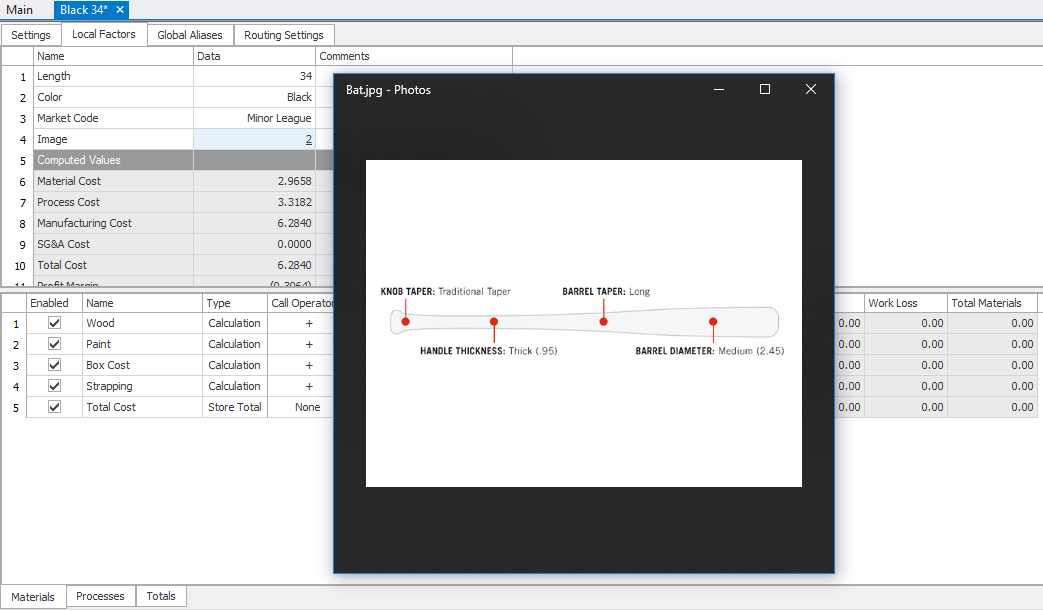
Viewing an image.
Get Started with File Attachments
Simple code changes can significantly expand the types of information available for ImpactECS model users. Not sure how to get started. As always, the 3C Software consulting team is happy to help walk you through best practices on adding file attachments. Don’t have 7.4 yet? You can learn more about the release or email us and we’ll help you get started.
Business Modeling & Analytics: Creating Value Requires the Right Technology
Evergreen writer Eric Jorgenson declares “the purpose of the institution of business is to create and deliver value in an efficient enough way that it will generate profit after cost.” If only it were as simple as it sounds! It’s bigger than checking boxes to produce reports, closing the books each period and remaining in compliance. To create real value, forward-looking finance organizations have moved beyond traditional finance activities and are establishing robust business modeling & analytics programs that provides detailed visibility into historical performance and expected results.
Establishing a Robust Business Modeling & Analytics Program
Companies are increasingly dependent on automation and analytics to deliver clear, actionable and forward-looking insights. With the explosion of available data from quickbooks desktop canada and the need to quickly evaluate it, finance teams are centered on two areas – the data and the models.
❶ Integrating data and accessing results:
As the size of the organization grows, so do the number of systems that support it. Companies can have hundreds of machines that generate endless data points along with groups of data warehouses, BI systems and other data sources holding information. Without a way to link data across the enterprise, it’s impossible to deliver meaningful insights or accurate results.
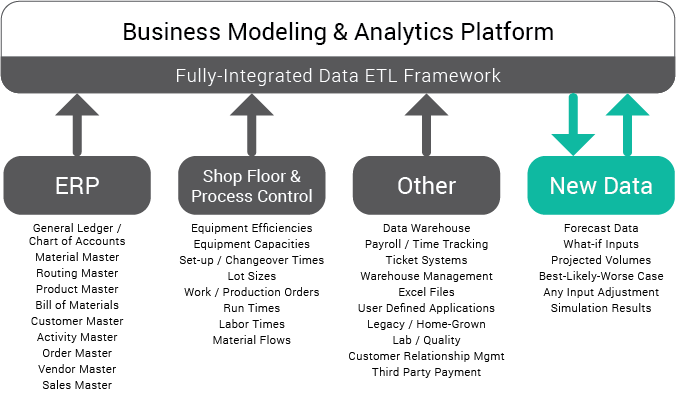
One shortcoming of most business analytics programs is the inability to integrate forecasted or simulated data as part of the modeling data set. Along with the expected data from ERP, shop floor and other systems, advanced analytics program recognize the need to retain and use forecasted or simulated data alongside historical data to predict performance and test assumptions for any data combination.
❷ Building models and running simulations:
The best models and simulations reflect real-world scenarios, not a pre-defined process or methodology, and delivers results in a timely manner. They must include measurable and meaningful KPIs that expose improvement opportunities and encourage behaviors that positively effect performance.
What is an integrated modeling platform, and why do you need one?
Most organizations have a few “system types” that provide, calculate, or share data as part of the planning and analytics process. The Business Modeling & Analytics Technology Landscape compares the different technologies and their attributes. The vertical axis measures the robustness of the system – or its ability to handle very large data sets and the ability to execute large sets of calculations quickly. Also, robust systems are scalable and can handle multiple users and permission sets. On the horizontal axis, the flexibility of the system represents the ability for the system to be configured to meet the company’s unique needs, both now and in the future.

Business Modeling and Analytics “System Types”
ERP: The ERP system is the system of record for organizations and serves as the transactional system. They are often limited by the design choices in the initial implementation, creating a rigid environment with no inherent simulation capabilities.
User Defined Applications: Many companies try to meet their analytical needs with applications developed internally. From legacy systems dating back to the 70s to AS400 and Access databases, User defined applications offer customized solutions, but their capabilities are often a reduced or partial set of controls. Additionally, simulation capabilities are limited to the programmed options, and changes to the system require IT involvement in maintaining and upgrading systems.
Spreadsheets: Desktop modeling tools solve a variety of challenges when it comes to creating a flexible modeling environment. It isn’t however, a system. That means limited controls and auditability will assure integrity issues. Further, spreadsheets are unable to scale with the requirements to build a robust modeling and analytics environment, and has difficulty handling larger sets of data.
Integrated Business Modeling & Analytics Platform: ImpactECS is an integrated modeling & analytics platform that leverages data from existing systems and delivers complete flexibility to design, calculate, manage, and report results that drive results by creating value. With a centralized approach, finance and planning organizations can link important data from across the company and build models to calculate, predict, or simulate performance at any level of detail or business dimension.
Each of these system types are critical and offer valuable benefits that keep the business running. However, organizations on a mission to create real value through analytics need to augment their IT footprint with technology that delivers the best of both worlds – a solid, enterprise-level system that connects relevant systems and data, and a flexible modeling platform to build, run, and maintain models that meet the company’s unique business requirements. Companies build models with ImpactECS for everything from detailed manufacturing product costs, cost-to-serve and distribution costs, and profitability analytics for any business dimension.
Visit us at www.3csoftware.com to learn more.
Charter Steel Rolls Forward With ImpactECS
15 February 2016
Atlanta, GA
FOR IMMEDIATE RELEASE
Charter Steel Rolls Forward With ImpactECS
Charter Steel, a division of Charter Manufacturing and a leading American supplier of carbon and alloy steel bar, rod and wire products, has selected ImpactECS as their enterprise wide cost and profitability modeling solution.
Headquartered in Saukville, Wisconsin, Charter Steel has rolling facilities in both Saukville WI and Cleveland OH, with additional full service facilities in Fostoria OH equipped to clean, anneal, draw, coat and distribute hot rolled coils coming from Charter Steel’s two primary rolling mills.
ImpactECS will provide Charter Steel with deep visibility into their manufacturing activity costs and company profitability on a product and customer basis. The project is focused on improving current margin reporting processes, reducing inefficiencies and improving profitability. Charter Steel is leveraging the 3C Software “Cost Management Ecosystem” template which provides a fully integrated approach to cost and profitability modeling.
“3C Software has a long history of providing cost and profitability management solutions to the metals industry and the opportunity to expand our reach to another industry leader further solidifies our expertise in this market” stated Scott Adams, Director of Sales at 3C Software. We are very excited to have Charter Steel join the ImpactECS family”.
About 3C Software
3C Software, developers of ImpactECS™ and Impact3C®, was founded in 1988 and is a leader in detailed cost and profitability management systems. Headquartered in Atlanta, Georgia, 3C Software serves clients in several industries including process manufacturing, distribution, and financial services. 3C Software’s rapidly implemented solutions work with all accounting methods, are simple to maintain, and handle unlimited calculations and variables. For more information about 3C Software or ImpactECS™, visit www.3csoftware.com or call 800-226-2036.
The Value of Providing More Accurate Costing- Part 1
This is the first blog of three on how management accountants can become more strategic advisers based on the article, Don’t Be Stuck in the Last Century, from Strategic Finance Magazine.
The main goal of management accounting is to understand the past, present and future of the business in order to help make strategic decisions. How can they understand their organization at such a granular level needed to make truly strategic decisions with outdated practices? A recent article in Strategic Finance magazine, Don’t Be Stuck in the Last Century, examines six areas of management accounting practices that concern business professionals, as well as ways to resolve these concerns. We’ll cover the first two areas in this post.
It is 2016 and many companies are still using accounting techniques that were used decades ago.
This image shows three different finance managers, all with different experience and different issues they are dealing within their particular organizations. The manager on the left is the most experienced and struggles with visibility of his company’s profitability. He needs real-time accurate profitability numbers so he can make more strategic decisions and make his organization more profitable. The middle manager wants more detailed allocations and company data so he knows if he is pulling his weight. The manager on the right does not like their accounting formats because she can’t manage them. She struggles to see the COGS and the value chain in the numbers and doesn’t understand the cost allocations. We want to explore how these managers can go about solving these issues so they can make the most strategic decisions for their companies.

Source: Don’t Be Stuck in the Last Century
Do Management Accountants Know What Their Internal Clients Want?
It is important that CFO’s understand the decision making needs of each department they serve because not all departments are the same. With the increasing use of technology and the internet, competitors are making faster business moves. Businesses need to realize how important it is to keep up with the changes in finance and technology to get to the forefront of the competition. Some of these changes include the timing of information and the level of detail and accuracy in their information. These are critical factors when it comes to strategic decision making.
The central issue is that CFO’s and other business leaders in the same organization see how to business should run differently. Some of these differences include the timing of decisions and how these decisions are made. Management accountants should learn how the business works and have open communication with all levels of the business so they are on the same page. Once the accountants and all internal parties know what to expect from each other, there can be an open line of communication which will aid in the strategizing for the company.
Do Management Accountants Care About Giving The Right Information to Internal Clients?
Now that we know that an open line of communication is necessary in order to know what each level of the business expects from one another, we need to make sure the right information is getting to the right people at the right time.
In some companies, CFO’s know that their management accounting data that is used internally for decision making is severely flawed, yet they do not do anything about it. Management accounting data is only useful if the data helps finance leaders make good decisions. If the data is flawed, it makes it much more difficult to make those strategic decisions. Every department has different data needs and it is important that management accountants recognize this and share correct data with the appropriate department so the business can make the best decisions.
These were the first two of the six areas of management accounting practices that concern business professionals. Stay tuned for part two in this blog series!
At 3C Software, we strive to help our customers be as strategic with their finances as possible. One of our main goals is to keep our customers up to date with the best of breed technology by using our enterprise modeling tool.
To learn more about how 3C Software can help your company make more strategic business decisions, Start Here!
To continue reading to Part 2 of this blog, Click Here!
3C Software to Exhibit at Financials 2016
3C Software is proud to announce that they will be exhibiting at SAPinsider’s Financials 2016 conference to offer proven advice to attendees. The event takes place at the MGM Grand in Las Vegas, March 15-18, 2016. Attend to learn proven methods for continuously improving and transforming key financial processes.
Every year, in collaboration with SAP, SAPinsider Events presents the most important Financials conference for professionals who use SAP® functionality for financial and managerial accounting, controlling, planning and analysis, cash management, reporting, closing, and consolidation. This event not only offers a detailed look at the entire range of capabilities within SAP financial solutions, it facilitates learning, networking, and one-on-one conversations with expert speakers.
If you’re able to attend the event, be sure to stop by 3C Software’s booth (#1100) in the exhibition hall. Our team will be ready to show you the latest tools to enhance you SAP cost and profitability capabilities with ImpactECS by 3C Software. We’re also hosting a conference session – “Improved Profitability Through Detailed Costing, Advanced Analytics, and Reporting” – where we’ll review case studies of four different manufacturing companies working to improve their profitability by leveraging financial and operations data.
You can get full details on the agenda, as well as receive a discount off the registration price by visiting www.financials2016.com/3CSoftware or by calling +1-781-751-8700.
Contact:
Paige Wilson
Marketing Associate
paigewilson@3csoftware.com
About 3C Software
3C Software, developers of ImpactECS™ and Impact3C®, was founded in 1988 and is a leader in detailed cost and profitability management systems. Headquartered in Atlanta, Georgia, 3C Software serves clients in several industries including process manufacturing, distribution, and financial services. 3C Software’s rapidly implemented solutions work with all accounting methods, are simple to maintain, and handle unlimited calculations and variables. For more information about 3C Software or ImpactECS™, visit www.3csoftware.com or call 800-226-2036.
About SAPinsider
SAPinsider, published by Wellesley Information Services, is the premier source of information on products, services, and strategic initiatives coming from SAP and its partners. More than 250,000 customers in 70 countries rely annually on education and training materials from Wellesley Information Services to optimise their investments in SAP solutions. Wellesley Information Services is the publisher of SAPinsider, insiderPROFILES, and the SAPexperts knowledgebases, and is the producer of SAPinsider conferences and seminars. For more information, visit www.SAPinsiderOnline.com.
SAP is a registered trademark of SAP SE in Germany and several other countries. Wellesley Information Services is not affiliated with SAP SE or any of the SAP SE group of companies.
SAP and other SAP products and services mentioned herein as well as their respective logos are trademarks or registered trademarks of SAP SE (or an SAP affiliate company) in Germany and other countries.
All other product and service names mentioned are the trademarks of their respective companies.
###
AdvancePierre Foods Advances Their Costs with ImpactECS
AdvancePierre Foods, a nationally recognized supplier of value-added proteins and sandwich products to foodservice, retail, schools and convenience channels across the United States, has selected ImpactECS by 3C Software as their enterprise budgeting and costing solution.
Headquartered in Cincinnati, AdvancePierre Foods employs more than 4,000 people and provides consistent product quality across 11 different facilities including manufacturing facilities in Oklahoma, Ohio and Iowa and sandwich-assembly facilities in North Carolina, Ohio and South Carolina. They also operate bakeries in Illinois, North Carolina and Oklahoma.
ImpactECS will provide AdvancePierre Foods a costing foundation that will enable full cost visibility across the enterprise. It will enable detailed analysis of current period costs and unlimited simulations of future cost projections.
“3C Software has a long history working with food producers to deliver cost and profitability systems, and the opportunity to expand our reach to another industry leader further solidifies our expertise in this area” stated Scott Adams, Director of Sales at 3C Software. “We are very excited to have AdvancePierre Foods join the ImpactECS family.”
About 3C Software
3C Software, developers of ImpactECS™ and Impact3C®, was founded in 1988 and is a leader in detailed cost and profitability management systems. Headquartered in Atlanta, Georgia, 3C Software serves clients in several industries including process manufacturing, distribution, and financial services. 3C Software’s rapidly implemented solutions work with all accounting methods, are simple to maintain, and handle unlimited calculations and variables. For more information about 3C Software or ImpactECS™, visit www.3csoftware.com or call 800-226-2036.
Accessing SAP Data with ImpactECS
SAP Connections are items that allow Queries and Script Modules to access data that resides in SAP. They are used in conjunction with SAP Adapters to invoke BAPIs on specific SAP systems. This allows developers to customize their solutions to work in both an automated or an on-demand fashion. The following instructions describe how to get started using SAP Connections.
Creating a new SAP Connection
Perform the following steps to create a new SAP Connection:
1. Log on to an ImpactECS Server using the Desktop Client.
2. Select the SAP Connections item in the Folders Panel, right click it and select New SAP Connection from the context menu.
3. Supply the appropriate information in the SAP Connection Properties dialog box and select OK to create the new SAP Connection.

Accessing SAP data using Queries
In addition to executing SQL statements against databases or OLEDB Providers, Queries also allow model builders to execute BAPI functions against SAP systems. This is best illustrated by walking through a simple example. Perform the following steps to retrieve a list of general ledger accounts for a given company code.
1. Open an ImpactECS Model and create a new Query named “GL Accounts”.
2. With the Query open, click on the Settings tab and set the Connection Name value to a valid SAP Connection (see above); then set the Maximum Records value to 0.
3. Next, click on the Query’s Text tab and enter the following statement:
![]()
4. Save and execute the Query. This will prompt you to enter the COMPANYCODE Query parameter.
5. Enter a valid company code (for example: 1000) and select OK to view the general ledger accounts associated with this company.

Accessing SAP data using Script Modules
Script Modules support two distinct options for accessing data that resides in SAP. The first option is to programmatically execute a Query that references a BAPI function (see above). The second option is to utilize the SAPAdapter’s CreateBAPIFunction method. The following Script Modules demonstrate how to implement these options.
Example 1: Accessing SAP using a Query object
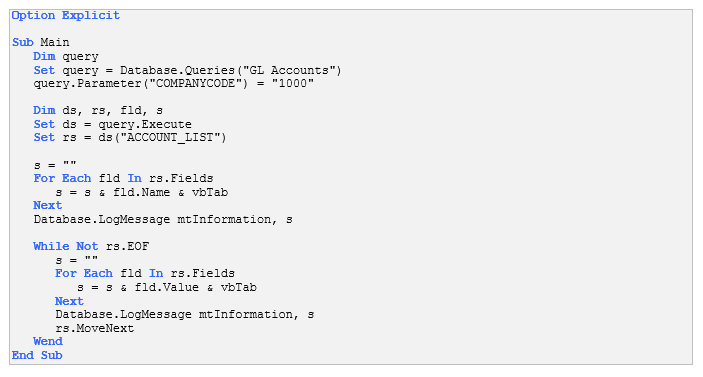
Example 2: Accessing SAP Using the CreateBAPIFunction method
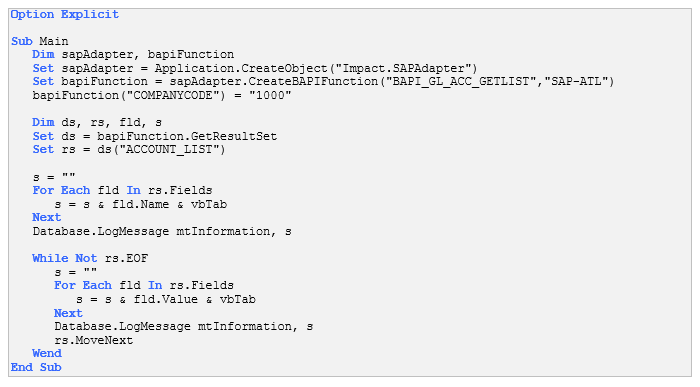
Papercon 2014 is Almost Here!
Are you headed to Nashville for Papercon 2014? Be sure to check out the session “Profitability, Margin, and Costs: Developing a Cost Object Model to Improve Overall Business Effectiveness” presented by Ben Whitaker, Director of Business Process Management at Mohawk and our very own Senior Business Analyst Randy Smith.
You’ll get to see first-hand how Mohawk uses ImpactECS to compete in the challenging paper marketplace and handle the constantly changing business climate. The session is part of the Product Development (PD) track of the Papermaking Program and will be held on Tuesday, April 29 at 10:30am. Check the conference schedule for location.

Papercon 2014 will be held April 27-30 at the Nashville Renaissance and Convention Center Complex. For more information and to register for the conference, visit papercon.org.


